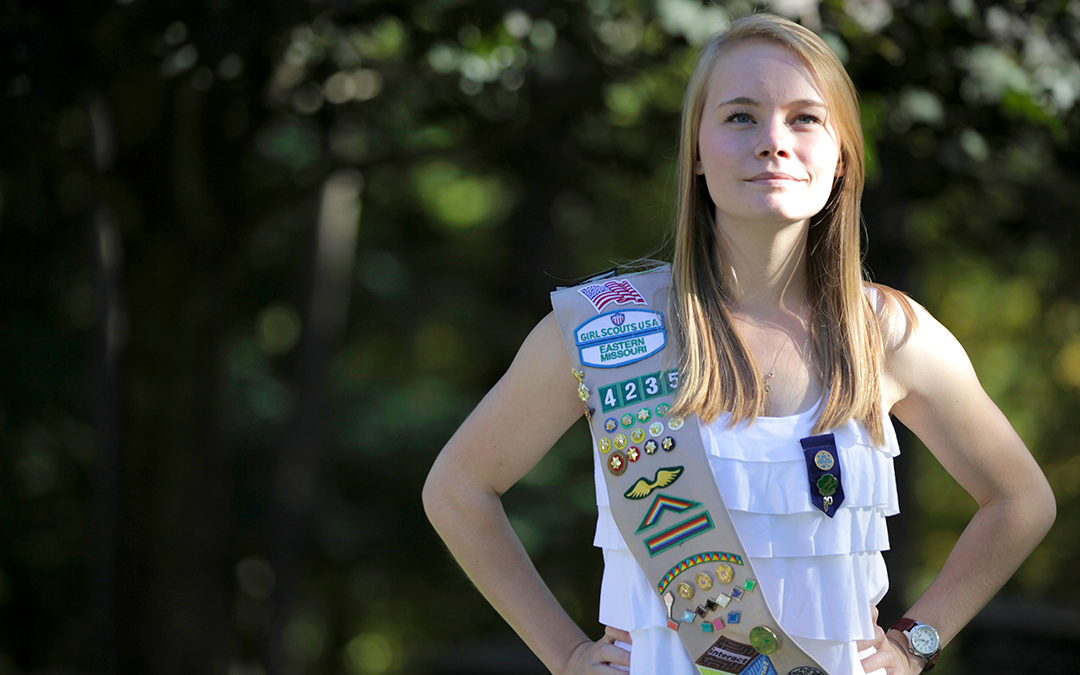October is the birthday month of Juliette Gordon Low, who dedicated her life to encouraging girls to become self-sufficient, and the perfect time to explore my favorite new Ambassador badge: College Knowledge! In Gordon Low’s day, “self-sufficient” meant knowing how to care for livestock and spin wool—today, it means finding a career where you can secure your financial future. Being an Ambassador means using Girl Scouts as a way to transition towards adulthood with the resources, support, and knowledge she’ll need to get where she wants to go.
If you and your Ambassador believe college is the best way to become “self-sufficient”, then you’re in good company. The Common Application, a non-profit organization that promotes equity in the college admission process, summed it up when they said, “College is your key to increasing your economic mobility and unlocking your earnings potential. Whether you dream of traveling the world or starting a family—your goals are attainable, but they require financial stability.” According to the Girl Scout Alumnae Impact Study, adults who were Girl Scouts for three or more years have attained higher degrees than their non-Girl Scout peers, and 66% of alums felt Girl Scouts encouraged them to set high goals and aspirations for their lives.
College Knowledge Badge in Five Easy Steps
Your Girl Scout may be feeling both excited about and overwhelmed by the college admissions process. The College Knowledge badge tackles applying to college one step at a time, so your girl can start her next chapter with confidence. Divided into five easy steps, this badge walks girls through their options, the admissions process, financial planning, and study and health habits so they can succeed after they get in!
Step 1: Explore Your Options
The first step in applying is, of course, figuring out where she might like to go! Girls are asked to choose three schools that interest them and compare them to each other in the following categories: Find Your Place, Investigate Your Interests, and Compare Your Program.
Find Your Place
Girls consider the location of their three schools and compare details like population densities (i.e., urban campuses vs. rural campuses), costs for living there, and access to transportation. Does she want to attend college in a major city? Will she have a car to get around, or does she need to rely on public transit? Knowing what environments her three chosen schools have to offer will help her narrow her choices to find a campus that suits her style.
Investigate Your Interests
This activity has girls research and compare clubs and extracurricular activities at their three chosen schools. Having sports, activities, and clubs that your girl is excited about isn’t just to make her college experience more fun—it will fill out her early resume, and help her build a support structure of like-minded friends at school, both of which will support her academic success! When girls read up on campus activities that align with their own personal interests, they’ll get a better insight into which schools might be the best fit for them.
Compare Your Program
Whether your girl is interested in marine biology, creative writing, or computer science, she’ll need to find a school that offers classes and majors in her fields of interest! In this step, Girl Scouts research the curriculum offered at their three schools and try to decide if one of these colleges can help them reach their career goals.
Step 2: Start the Admissions Process
With this step, Girl Scouts learn first-hand how each college has its own process for accepting students. Girls will learn about the different requirements and tips that will aid their application process, and get to practice writing essays and interviewing!
Apply Yourself
After getting resources from their college admissions counselor, or finding older applications from one of their three chosen schools online, girls can practice filling it out to learn about the kinds of questions they might be asked, and hunt down the necessary information they will need. Make sure the girls know that troop leaders and parents are happy to review their materials and provide feedback.
Do Your Best on the Test
The SAT and ACT are important parts of most college applications. This step helps girls improve their test-taking skills by exploring the many resources available to them, such as prep classes, tutors, or online practice tests.
Share Your Story
Scouts investigate the admissions essay and interview process and how colleges use these methods to learn more about prospective students. To prepare, have them think about challenges they’ve overcome, times where they’ve learned and grown, and passions they’ve discovered—don’t forget to think about and include Girl Scout experiences when brainstorming examples of what makes a girl stand out! Girls can stage a mock interview panel to give the troop members first-hand experience, or read each other’s essays round-robin style offering constructive criticism.
Step 3: Make a Financial Plan
College costs money, so the next step is to learn about all your options. Girls learn about the costs involved with tuition and expenses, and brainstorm ways to help pay or save money. Some of the other financial components girls learn about college expenses include:
Research In/Out of State Tuition Costs
Girls learn about the differences in base tuition costs for in-state and out-of-state schools and think of money saving tips to help make these costs affordable. There are so many opportunities—for example, did you know that the UCs are much less expensive for in-state students than for out of state students? But other states may have lower costs of living, lowering your expenses for the year. Take the time to weigh all of the options!
Find Out About Scholarships
Girls learn how to find and practice applying for scholarships or other financial assistance. Scholarships aren’t just for girls with high grades and GPAs—there are all kinds, like scholarships for sports, special interests and talents, traits like race, sexual orientation, gender, and socio-economic status, her family’s veteran status, and more! You can even get a scholarship for being a Girl Scout! Even small scholarships can add up when you apply to many of them, and make college more affordable.
Compare Costs of Public, Private, and Junior College
In this step, Girl Scouts compare the costs of pursuing their chosen field at the public, private, or junior college level to get an idea on pricing. They can learn about these different options and whether they are right for them and their families from either their troop leader or family members. If your girl isn’t sure about her future major or field, she can consider Junior college for her general education requirements, and then transfer somewhere else if necessary when she has a better idea of her specific goals.
Step 4: Get Set for Success
Success in college isn’t just about getting in! It can be a big change for girls! They’ll gain new independence, some of them living away from home for the first time ever, and that can be intense and stressful even when things are going well. To make sure she gets the most out of her education, this step helps Girl Scouts build and refine healthy study habits and take an active role in planning a positive approach to college academics. Some of the topics girls can review in this section include:
Study, Buddy
With this step, girls learn how to improve positive studying habits and make a plan for when, where, and how long they will study at college. Girls can explore everything from study locations to how other time commitments (i.e., jobs, sports, etc.) might interfere with studying. The goal is for the girls to develop their own tips on how they will make the grades, despite the heavier (and harder!) coursework.
Plan for Academic Integrity
Girls pick one of their target universities and review that school’s Academic Integrity Code, including about plagiarism, cheating, or misquoting information on term papers or reports. Encourage your Girl Scouts to talk about what it means to be “honest and fair” under the pressure of academia, and ask them what they do if they saw a fellow student violating one of these codes.
Prevent Procrastination
Procrastination happens sometimes, but this step helps girls find effective ways to overcome the temptation to put off school work “just a little bit longer.” Have them practice making and designing to do lists (bullet journaling or buying a planner could be an excellent option!), analyze how best they should prioritize tasks, think of small rewards or celebrations they can use to motivate themselves, and discuss ways to hang in there and turn in good work even when the subject isn’t their favorite.
Step 5: Build Healthy Habits
Outside of academics, a big part of college is growing up into a responsible and mature adult! Step 5 sets the girls up to consider healthy habits that they will need as they launch their new, independent adult lives. Talk about the importance of balance in their college careers and take a long and deliberative look at the following areas where they can make healthy decisions:
Be a Self-Starter
Girls can create their own mock calendar that budgets in-class and study time, rest, meals, activities, and exercise. Your Girl Scouts will soon realize that it’s up to them (and not their parents) to strike a healthy balance between all of these demands for their time, and that a little of all these elements are needed for a happy, healthy college life.
Balance School and Socializing
Building off the previous step, it’s important that girls learn that, while being a total party animal in college isn’t going to be great for her grades, living in the library is not a healthy solution either! Discuss ways your girls can find a balance between getting good grades and building relationships with professors with all of the amazing social opportunities they’ll encounter in college: spending time with new friends, joining cool clubs and activities, playing sports, and exploring their new home city as a young adult!
Manage Stress
This exercise is one the girls can carry with them well into adulthood, even after college is done. Girl Scouts are encouraged to research and test three different ways to prevent and manage stress. Girls can track their stress levels over a course of a few weeks, and note the causes of stress in their lives, and record how they reacted to those stressful events. Discuss with them which methods worked best for them, and which didn’t, and what kind of support system they need to build to avoid stress in the future.
How You Can Help
You can work on this badge during a regular troop meeting! Giving girls the space to share their college worries, hopes, and dreams with each other is exactly what the girl-led, girl-supported space of Girl Scouts is for. Watch as they bounce ideas off each other, support each other’s goals, and provide encouragement as they take this next big step together.
For more active meetings to support their College Knowledge badge, living in Northern California means you have easy access to many private colleges and public campuses right in your own backyard. Talk to your girls about the colleges they are interested in, and contact those admissions offices to ask about a campus tour for your troop, or schedule an appointment with student housing staff to tour a dorm and dining hall.
To get you and your girls started, here is a list of some of the colleges in the Girl Scouts of Northern California service area with information on general campus tours.
| Community Colleges Butte College Chabot College College of Marin College of the Siskiyous Mission College Monterey Peninsula College Ohlone College Santa Rosa Junior College Shasta College | Four-Year Colleges/Universities Menlo College Mills College Saint Mary’s College Santa Clara University Stanford University University of San Francisco | California State University Campuses East Bay Humboldt Maritime Monterey Bay San Francisco San Jose Sonoma | University of California Campuses Berkeley Davis Santa Cruz |
Pro Tip: Looking for a particular community college campus in California? You can check the California Community Colleges Registry for a complete list of schools.
When all the activities are done and that badge is firmly fixed to their sash or vest, it won’t be just another award they’ve earned in Girl Scouts—it will symbolize their dreams of the future, and their verve and determination to plan and accomplish that future. The Ambassador College Knowledge Badge should tell your girls one simple thing: college is right around the corner, and well within their grasp. Get started supporting and planning their collegiate futures today!
What to do next:
- Get started on the College Knowledge badge! The badge requirements are available in the Volunteer Toolkit, on the online Girl Scout shop, and at your local GSNorCal shops.
- Adulthood doesn’t have to be the end of her Girl Scout experience. Encourage your girls to add their Girl Scout experience to their resumes (or their college admissions essays) and follow these steps to keep them involved in Girl Scouts after graduating from high school.
- Support your girls who are interested in earning higher awards. The Girl Scout Gold Award (as well as other Girl Scout leadership experiences and awards) is impressive on a college application, may qualify girls for more scholarships, and will help girls develop many of the time management and research skills necessary to succeed in college!
 Marlene Smith—Marlene is the troop leader with Girl Scout Troop 30760 in Walnut Creek and has been a Girl Scout Volunteer for ten years. She is proud to say that Troop 30760 boasts many Journey awards and some girl members who have been with the troop for 10 years (yahoo!). Marlene was a Girl Scout herself whose greatest claim to fame was earning her “My Camera” badge. Most importantly, Marlene’s favorite Girl Scout Cookie flavor is Thin Mint.
Marlene Smith—Marlene is the troop leader with Girl Scout Troop 30760 in Walnut Creek and has been a Girl Scout Volunteer for ten years. She is proud to say that Troop 30760 boasts many Journey awards and some girl members who have been with the troop for 10 years (yahoo!). Marlene was a Girl Scout herself whose greatest claim to fame was earning her “My Camera” badge. Most importantly, Marlene’s favorite Girl Scout Cookie flavor is Thin Mint.



I wish they’d had this badge years ago. Both of my daughters’ troops went on college visit trips throughout California, on the way to Disneyland. I love the new badges!
Thanks Lorraine. I agree-this badge is a timely idea. I also think we’re lucky to have access to so many prestigious public and private campuses for scouts to get a first hand look at “college life.”
Great post, Marlene! I’m really excited this new badge exists – as a first generation college student in my immediate family, I navigated the application process entirely on my own, which made it extra hard. (And I ended up applying to over 60+ schools, because I had no concept of where I’d be able to get in!) It makes me happy to see that Girl Scouts who don’t have family support will now have this resource available to them!
Many thanks, Marissa! This whole process can be exciting and terrifying all at the same time. Can’t wait to see how our Ambassadors tackle this badge and make the journey their “own.”